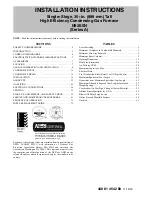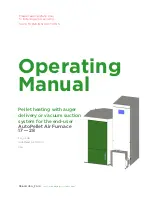
1-866-413-5214
Quest Oil Fired CHH-980 Installation, Operation and Maintenance Instructions
25
quest
quest
www.QuestProtect.com
sales@QuestProtect.com
a. Check the set points on the high temperature auto switch (Fig. 25) and digital stat (Fig. 13). If the
set point of the stat is equal to or higher than the set point of the high temperature auto switch (Fig. 25),
the high temperature auto switch will be functioning like a stat and cycling the burner off and on. Light
#3 will be cycling in-step with the burner. The digital stat should always be set (maximum 200ºF), a few
degrees lower than the high temperature auto switch (about 210ºF).
b. With the actual fluid temperature well below the set point of the high temperature auto switch,
check, with a multi-meter, for 120V in and out of the high temperature auto switch (Fig. 25). If there is
power in but not out, replace the high temperature auto switch.
#3 High Temp. Limit Light, (plus #1 & #2) are ON indicates.
A. Fluid supply temperature is below the set-point of the high temperature auto switch (Fig. 25) and power
is going through the switch.
B. There is no power going through the high temperature Limit switch (Fig. 26).
a. Check the set points on the high temperature Limit switch (Fig. 26), the high temperature auto switch
(Fig. 25) and digital stat (Fig. 13). If the set points of both the high temperature auto switch and the stat
are equal to or higher than the set point of the high temperature limit switch (Fig. 26), the high temp
limit switch will be locked out and the burner off. Light #3 will be off. It will be necessary to push the
manual reset button on the front of the high temp limit switch and check the set points of all 3: The high
temp auto switch (210ºF), the high temp limit switch (220ºF) and the digital stat (maximum 200ºF).
b. With the high temp limit switch re-set and actual fluid temperature well below the set points of both
high temp switches, check, with a multi-meter, for 120V in and out of the high temp limit switch (Fig.
26). If there is power in but not out, replace the high temp limit switch.
#4 High Pressure Switch Light, (plus #1, #2 & #3) are ON indicates.
A. Fluid supply temperature is below the set-point of the high temp limit switch (Fig. 26) and power is
going through the switch.
B. There is no power going through the NC contacts of the high pressure switch (Fig. 27).
a. Check the set-point of the high pressure switch. Start by turning the adjuster screw all the way
counter-clockwise. Then turn the screw clockwise 3 full turns. Push the manual reset button on the
pressure switch to restore the circuit.
b. Check the air tube connection to the pressure switch and clean if necessary. Push the manual reset
button on the pressure switch and the circuit should be restored. If not check for 120 volts going in and
out of the control. If power goes in but not out, replace the control.
c. If the circuit is restored briefly but it trips again, blockage may have occurred in the flue gas
passage way. Clean the flue gas passages in the combustion chamber (see Maintenance article 6.1 G for
instructions) as well as the chimney pipe and rain cap. Repeat step a) above.
#5 High Pressure Switch Light, (plus #1, #2, #3 & #4) are ON indicates.
A. Pressure in the combustion chamber and flue pipe has not risen above the high limit cutoff point. Power
is going through the NC contacts of the high pressure switch (Fig. 27). Indicates no blockage in any of
the flue gas passages.
B. There is no power going through the digital stat switch contacts (Fig. 13).
#6 Stat Light, (plus #1, #2, #3, #4 & #5) are ON indicates.
A. The digital stat (Fig. 13) is calling for heat. The burner should be engaged.
B. If the burner is not functioning, a fault lies within the burner.






































